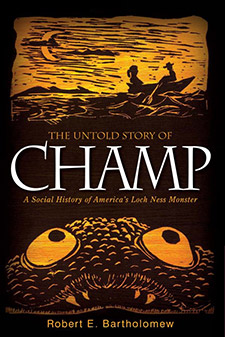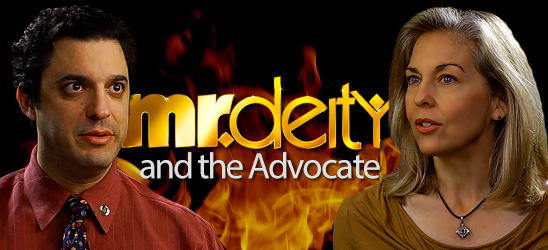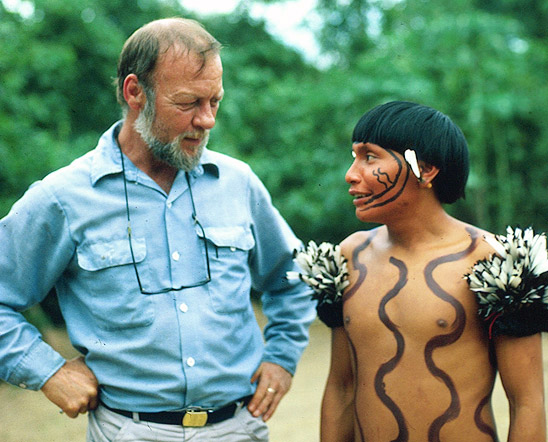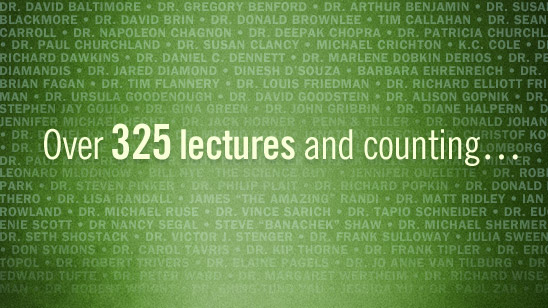In this week’s eSkeptic:

Weak Are The Champ Puns
The shores of the lake were packed with strangers looking to catch a glimpse of the beast. A $50,000 reward was issued for its capture. Newspapers around the world carried the story of the strange creature that was said to lurk beneath these waters. Loch Ness? No—this is 1880s Vermont and the monster is alleged to be living in Lake Champlain. in this episode of MonsterTalk, Robert E. Bartholomew joins us to discuss his latest book, The Untold Story of Champ: A Social History of America’s Loch Ness Monster.
The Latest Episode of Mr. Deity: Mr. Deity & the Advocate.
WATCH THIS EPISODE | DONATE | NEWSLETTER | FACEBOOK | MrDeity.com
About this week’s eSkeptic
In this week’s eSkeptic, we present an excerpt from Frank Miele’s interview with Napoleon A. Chagnon, usually described as “the most controversial anthropologist,” hero to some, villain to others. His studies of the Yanomamö of the Amazon basin formed a cornerstone in the application of sociobiological theory to humankind. Chagnon himself helped found the discipline of evolutionary psychology and the Human Behavior and Evolution Society (HBES). However, his findings were disputed by other anthropologists who argued for the primacy of culture over genes and evolution.
Then, in 2000, Chagnon found himself demonized and his work denounced in the popular press. The American Anthropological Association first condemned Chagnon, only to rescind the condemnation by a 2–1 vote in 2005. In 2012 he was elected to the prestigious National Academy of Sciences, seemingly settling the dispute in his favor.
However, publication of his new book, Noble Savages: My Life Among Two Dangerous Tribes—the Yanomamö and the Anthropologists (Simon & Schuster, 2013) has set off new battles in the anthropology front of the apparently never ending nature-nurture wars. Order the Kindle Edition
The complete interview will be published in Skeptic magazine 18.2, due out this summer.
All images used herein are courtesy of Napoleon Chagnon. Used with Permission.
Share this article with friends online.
Click the + for more options.
Savage Science: Excerpt of an Interview of Napoleon A. Chagnon
by Frank Miele, Senior Editor, Skeptic Magazine
Skeptic: In Noble Savages, you describe how you first began your scientific studies of the Yanomamö in 1964. As you describe them, they were isolated from the outside world.
I want to go back all the way to the 1500s when Spanish conquistador Francisco Orellano, described a highly developed culture, possibly a civilization in Amazonia. Up until a few years ago, his account was written off as another wild tale of “El Dorado.”
Recently, Charles Mann’s book 1491: New Revelations of the Americas Before Columbus (Knopf, 2005 ) has summarized the finding of “terra preta” (Portuguese for “dark earth” because of its high charcoal content). Some anthropologists have accepted that as evidence of an Amazonian civilization that was decimated by the diseases brought in by the original European conquerors.
The Yanomamö aren’t pure hunter-gatherers, like, say, the !Kung of the Kalahari. The Yanomamö grow plantains, which are native to the Old World, not to the Americas, and so must have been introduced by the Europeans.
Doesn’t all this lend credence to the argument, as accurate a picture as you have drawn, that the Yanomamö society you observed, be it fierce or gentle, was not a “pristine” relic of what human society was like in the past. Rather it’s one of refugees from, for lack of better term, a “holocaust,” or a succession of “holocausts,” that began 500 years ago and is still going on? Some critics have even likened it to Iraq after the “shock and awe” of the U.S.-led war. Any comments?
Napoleon Chagnon: Yeah! Do you really think that about the Yanomamö after reading my ethnographic research on them?
SK: My job at Skeptic is to ask the questions, not answer them.
NC: My job is to give commentary and I think that’s a preposterous suggestion.
It’s entirely possible, as Eric Wolf pointed out in his book Europe and the People Without History (University of California Press, 2010), that all human societies have been “contaminated” by contact with more complex societies. That’s the nature of human existence. After the first hunter gatherers began to cultivate a few tiny little crops that they managed to control, the entire world was changed. No society is pristine and absolutely pure.
My position, as stated many times in my publications, is that at the time I visited them, the Yanomamö were merely the best approximation anthropologists could have to examine the life of a people living completely free and ignorant of the cultures that surround them.
They’re not completely independent of these cultures because steel tools have dribbled into the Yanomamö area for years and years and years. New cultigens like bananas and plantains arrived in the 1500s. The Yanomamö claim that plantains have existed from the beginning of time. But we know historically that cannot possibly be true because plantains are an Old World crop.

Club fighting scars
The point is that the Yanomamö are completely unaware, or at least they were in 1964 in the villages I studied, of countries called Brazil and Venezuela. They are increasingly aware of these countries because they now have contact with outposts of the civilizations in both of those countries and some of them are now able to say a few words in Portuguese and/or Spanish and because now that missions have been established by the New Tribes evangelicals and the Salesian Catholics, they are now going to school and learning to read and write and, at these missions, many of them are relatively fluent in either Spanish or Portuguese.
But that was not true in 1964. Then the Yanomamö were quite innocent and naïve about the external world they lived in. As far as they were concerned, they were the only people on the planet. And their word for non-Yanomamö is “nabä,” which covers anything from Canadian bankers to missionaries to the King of Spain!
SK: Do they regard these nabä as human beings?
NC: No they don’t. So they are behaving very much like they existed in the relatively pristine times of our human past.
SK: Most importantly, let’s turn to the science. What were the two heresies you proclaimed in your publications on the Yanomamö that went against the prevailing orthodoxy in anthropological community?
NC: Well, I didn’t realize until I began committing these heresies, how entrenched that orthodoxy was. The first reaction was to my having described the Yanomamö as having wars and being quite violent in the absence of provocations from outside societies or the presence of military units from organized political societies, like a nation-state, first punishing them. At that time, they didn’t have any states surrounding them that had any influence on their behavior.
So, without realizing it, I was threatening the general attitude within anthropology that all native peoples are pacific and live an angelic kind of life, gliding through the jungle with lithe, scented bodies, being altruistic, sharing their food, and willing to cooperate with the stranger that comes in and wants to learn about them and their culture, and anxious to share their knowledge and life histories with that stranger.
Well, they aren’t that way. And my descriptions apparently annoyed my colleagues that some of them began to publish statements “correcting” me.
Prof. David Schneider, a distinguished anthropologist at the University of Chicago, for example, couldn’t believe that these people weren’t just fighting, but fighting over women. The canon in anthropology about tribesmen like the Yanomamö according to Marvin Harris, for example, was that they rarely fought among themselves, and if they did at all, it was over scarce, strategic, material resources. Just like we do.
I found the Yanomamö quite violent, without any outside provocation making them so, and that their violence revolved around competition for women. Specifically, there was chronic and sometimes violent competition to obtain nubile, young females.
Schneider wrote me a note that said, “Fighting over women? Gold and diamonds I can understand. But women, never.” I found that not only humorous, but a very Eurocentric, even ethnocentric statement. Because we fight over “gold and diamonds,” we assume that it’s natural to do that and project that kind of attitude back into the Stone Age or to living tribesmen.
The late Marvin Harris of Columbia University, also a very distinguished anthropologist at the time, told me about a book he was publishing. It’s a remarkably good book, The Rise of Anthropological Theory (Rowman Altamira, 2001) on the history of anthropology and his struggle to create a science of materialistic anthropology. He included a comment based on my doctoral dissertation, in which he stated, that the claim by John McLennan, a 19th century academic who got interested in native peoples, that “marriage by capture” was a stage in the evolution of culture that every group went through, had very little support. Harris said McLennann’s speculations about marriage by capture were interesting and the work of Chagnon among the Yanomamö lends some credibility to such “lurid speculations.”
Now if a scientist studying yaks, bullfrogs, bats, deer, salamanders, or any non-human animal stated that they competed for opportunities to mate, no one in biology would have taken that to be anything other than an accurate observation. But if you say that about human beings, it becomes “lurid speculation.”
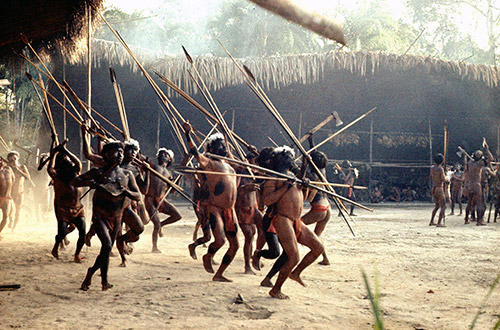
Yanomamö dance
SK: It’s hardly “lurid speculation” to someone like me who grew up in a mob town in Jersey and spent (or misspent) a lot of time back in my military service days shooting pool in bars. I didn’t make careful anthropological observations, but I saw that behavior regularly.
And while I was in college at the same time I was learning the prevailing orthodoxy in my introductory anthropology course, I was also taking a course on the classical culture of Ancient Greece in the very next building, where we read in The Iliad about Helen, Paris, Menelaus and the Trojan War. So why was “males fighting over females” considered so heretical?
NC: It may be that a number of cultural anthropologists come from a general class of the American public that goes to private high schools and elite colleges and universities and ends up teaching in major universities. Not enough of them have spent time in pool halls and bars, as maybe you and I have, so they haven’t anything called common sense.
One of the long threads in the evolutionary psychology website (Robert Karl Stonjek’s yahoo group, evol_psch_news) about my book, Noble Savages, was touched off by a former University of California, Santa Barbara graduate student, Larry Fiddick, who is now a Ph.D. and has a job at a university, replying to some of the comments that others had made about it. He said that a lot of people don’t realize that Chagnon grew up in a very poor community and he has rather lower-class tastes because he drinks beer and he hunts. You’re probably in the same category, Frank. You go to bars, shoot pool, and drink beer.
SK: I’ve done all of those.
NC: Then you probably have more common sense. Not many anthropologists, especially in North America, do such things. That may be part of the explanation why I am so despised in certain quarters. I don’t know.
SK: If you simply reported your observations about violence, specifically over women, among the Yanomamö, they might have simply been accepted as “the exception that proves the rule.” But you did something further that challenged the prevailing orthodoxy far more.
In your famous article in Science (the leading science journal in the U.S. and read by researchers, professors and students in all fields), you explained your findings in terms of a general theory (sociobiology) and used them as evidence to support it against a purely materialistic (i.e., non-biological) theory of human behavior. What specifically did you say?
NC: I reported in my 1988 article, “Life Histories, Blood Revenge, and Warfare in a Tribal Population” (Science 239: 985–992) that unokais (men who had killed others) had 3 times the average number of children than same-age non-unokais and 2.5 times the average number of wives.
SK: Let’s review the career of Napoleon Chagnon. While you had your debates with other anthropologists, your work was considered a landmark. Your book, Yanomamö: The Fierce People (Holt: 1968; 1977), was the best selling anthropological monograph of all time, displacing even Margaret Mead’s Coming of Age in Samoa (Morrow: 2001 [Oxford: 1928]).
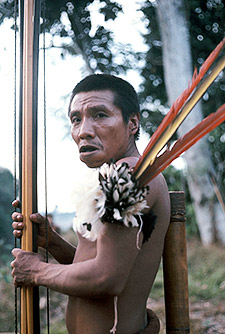
A member of the Yanomamö tribe
Then Patrick Tierney’s book Darkness in El Dorado: How Scientists and Journalists Devastated the Amazon (Norton, 2002) appeared and you and your colleagues had to spend your time defending yourself against the charges of alleged misfeasance and malfeasance and complicity in homicides and even genocide. You retired from the University of California at Santa Barbara, went back to your native Michigan, to write Noble Savages.
Your election to the prestigious National Academy of Sciences (NAS) could be seen as an indication that the allegations against you had proven to be exaggerated or without substance and that the tide in anthropology had turned in the pro-Chagnon direction.
Then just the other day I see that another very distinguished anthropologist, Marshall Sahlins of the University of Chicago, who I believe was one of your professors, announced that he was resigning from NAS in protest of your election. Any comment?
NC: His resignation in protest of my election is rather strange. I’m puzzled why it took him so long to announce it. I was elected to NAS in April 2012. Why did he resign in February 2013? He must be slow on the uptake.
SK: Do you think his resignation was elicited by the publicity splash for Noble Savages?
NC: It very possibly was. My prediction is that Sahlins is going to be trounced in what he used as evidence of my alleged malfeasance. There are lot of people who know the Yanomamö and my research. Some of them have been longtime associates of mine, and some are people with whom I spent time among the Yanomamö.
I think Sahlins’ information comes largely from reading Patrick Tierney’s now debunked Darkness in El Dorado. The first reaction to his resignation that I’ve gotten from a lot of my colleagues who are very prominent in their own respective spheres of science appears to be “good riddance.”
SK: When the final words are written on Napoleon Chagnon and his critics in academia and in the media, what do you think they will be?
NC: I have no idea! Who’s going to write them? If they’re post-modernists they’re going to say something very different from what a scientist would say.
Are you assuming that whoever writes these words about Chagnon will be a rational human being with common sense who believes in the existence of the real world independent of its observer?
SK: As Skeptics we have a faith which, much like a religious faith, is not itself provable. It’s a faith that in the end demonstrable truth will win out, however unpleasant or unpopular. And while there will be swings to the irrational or the incorrect here and there, in the long run reason and experiment will triumph, just as they have in medicine and so many other fields.
NC: If that’s the kind of person that’s going to write the epitaph on my existence and my work I think they will come to the conclusion that you have suggested. Namely, that my research and my commitment to science have won the day and that the observations I made can be verified so long as there are Yanomamö alive that are not living in Salesian missions.
SK: And what will be the future of the Yanomamö? Will they continue to live in a reserve or should they be integrated into the greater society? Venezuela is rolling in oil money right now. Surely it can do something for the benefit of its indigenous peoples.
NC: Venezuela has been rolling in oil money for many years and it has had very little effect on the fate of the Yanomamö. The government of Venezuelan has not only not used a portion of its oil wealth to provide medical aid, for example, to the Yanomamö, they have energetically opposed others like charitable NGOs, from doing so. I cannot decide what’s going to happen to them. They are eventually going to be absorbed into the greater national populations of Brazil or Venezuela.
There’s not much I can do to affect that one way or the other. I can’t even return to the Yanomamö area in Venezuela because of the hysterical opposition to my presence—by not the government of Venezuela but by the Catholic Salesian missionaries—who are the government in the Yanomamö area, the last Theocracy in the Americas. To be sure, the existence of modern medicine is going to be a blessing to Yanomamö and will alleviate their pain and suffering from various diseases. As they become absorbed into the national cultures of Venezuela and Brazil it will be increasingly difficult to verify many aspects of what I have observed and reported during the time I lived among them.
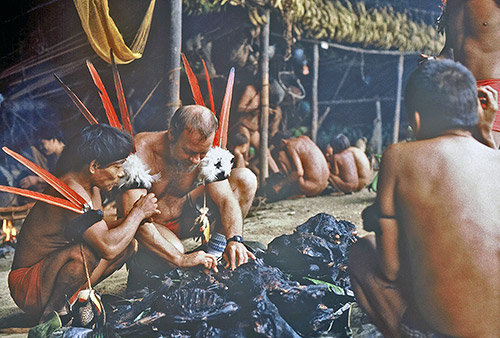
Chagnon, Alto Mavaca (1986)
SK: And recently you’ve joined the faculty of the University of Missouri at Columbia. What will you be doing there? Teaching, conducting new research, analyzing the data you’ve already collected?
NC: I accepted a position on the Anthropology faculty of the University of Missouri at Columbia because they have such a dynamic faculty, one that would make others comfortable there regardless of their theoretical preferences…including people like me who unflinchingly defend the scientific method. But this faculty also includes a number of younger members whose research interests are nearly identical to mine—evolutionary approaches to understanding humans and their behavior.
My efforts will be primarily directed at the analysis of my existing data and collaborating with faculty (and possibly with advanced graduate students) on the large amounts of unpublished field data I brought to the University of Missouri in the analytical development and publication of new scientific papers and, perhaps, new books based on these data. I will also teach classes, but that is not primarily the reason the University Administration brought me to Columbia.
These are exciting times for me…and hopefully for them. Finally, a complete archive of my data will eventually be available to other researchers through both the University of Missouri and the University of Michigan, where I also hold an appointment as Research Scientist in the Inter-university Consortium for Political and Social Research (ICPSR), a unit in the University of Michigan’s Institute for Social Research (ISR).
SK: And we thank you for your exciting book and this exciting interview. ![]()
An expanded version of this interview will appear in Skeptic magazine, volume 18, number 2
(later this summer). Download the free Skeptic Magazine App for iOS, Android, PC, Mac, Blackberry PlayBook, Kindle Fire, and Windows 8 devices and get the digital issue usually about a week before it hits the newsstands in print! The app comes with a free 44-page Preview Issue.
About the Author
FRANK MIELE is Skeptic magazine’s Senior Editor and the author of The Battlegrounds of Bio-Science (AuthorHouse, 2002), a collection of his Skeptic magazine articles, book reviews, and interviews on the Nature-Nurture Wars with cutting edge behavioral scientists including E. O. Wilson, Richard Dawkins, Donald Johanson, and Robert Sternberg; Intelligence, Race, and Genetics: Conversations with Arthur R. Jensen (Westview Press, 2002); and (with Vincent M. Sarich) Race: The Reality of Human Differences (Westview Press, 2004). Miele’s Skeptic articles have appeared on the Human Behavior and Evolution Society and other websites and been assigned as reading at colleges in the U.S., Europe, and Australia. He has appeared on National Public Radio, spoken at Columbia University, and at various scholarly conferences as well as being a feature speaker for the Skeptics Society.
Our Next Lecture at Caltech:
DR. MARC RAYMAN
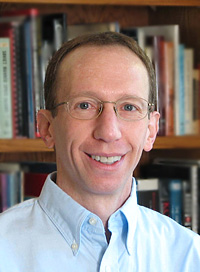
To Boldly Go…Well, You Know: NASA’s Dawn Mission to the Asteroid Belt
with Dr. Marc Rayman
Sunday, March 17, 2013 at 2 pm
THE AMBITIOUS DAWN MISSION, launched in September 2007, is one of NASA’s most remarkable ventures into the solar system. The spacecraft has recently completed a spectacular exploration of Vesta and is now traveling to Ceres; these were among the last uncharted worlds in the inner solar system prior to Dawn. They are the two most massive residents of the main asteroid belt. Ceres is so large that it is included in the category of dwarf planets, along with Pluto. Remnants from the time that planets were formed, Ceres and Vesta hold clues that will help scientists understand the dawn of the solar system. Dawn orbited Vesta from July 2011 to September 2012 and returned astonishing views of this fascinating world. It is the only spacecraft ever to orbit an object in the asteroid belt. Such a mission would be impossible without the use of ion propulsion, a technology that has mostly been in the domain of science fiction, but which was tested extensively on the Deep Space 1 mission, paving the way for Dawn. Dr. Marc Rayman, Dawn’s Chief Engineer and Mission Director at JPL, will describe the Dawn mission and its use of ion propulsion as well as its two exotic destinations. He will also share the excitement and profundity of controlling a spacecraft in deep space.
Followed by…
- Give and Take: A Revolutionary Approach to Success
with Dr. Adam Grant
Sunday, April 28, 2013 at 2 pm - Odd Couples: Extraordinary Differences between the Sexes
in the Animal Kingdom
with Dr. Daphne J. Fairbairn
Sunday, May 19, 2013 at 2 pm
New Admission Policy and Prices
Please note there are important policy and pricing changes for this season of lectures at Caltech. Please review these changes now.


